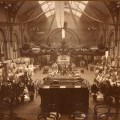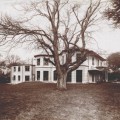The Empire Bazaar and Christmas Fete 1922
3 December 2020
- Empire Bazaar stalls at Loughborough Town Hall, December 1922 (Loughborough University Archives)
- The Grove in the 1920s
As December thoughts turn to shopping for Christmas presents, Jenny Clark reminds us of the longstanding link between ‘town and gown’ in Loughborough and tells the story of the part townspeople played in establishing ‘the Grove’ as a hall of residence.
By 1922 Loughborough College had developed from a tiny pre-war Technical Institute providing classes for local people, via its role as a wartime Instructional Factory for the Ministry of Munitions, to an engineering college with a growing reputation. By the end of the 1921-22 academic year it had more than 1,200 full time students. Only about 200 of these were housed in its five existing Halls of Residence and the College was anxious to increase its residential accommodation. When ‘The Grove’ on Ashby Road came up for sale, Principal Schofield determined to purchase it. To help raise funds an elaborate Bazaar and Christmas Fete was planned, to be held in Loughborough Town Hall.
The Bazaar was to take place over four days in early December – a convenient time to catch the Christmas shopper. The Duchess of Rutland was secured to open it on the first day, the respective wives of the High Sheriff of Leicestershire and the local Member of Parliament on the second and third days, and the Mayoress of Loughborough on the last day. The report on the opening of the Bazaar in the College magazine The Limit notes that ‘the speeches throughout were of varying degrees of length, audibility, and unvarying interest’.
There were thirteen stalls organised and run by different sections of the college and by the townswomen of Loughborough. The stalls were named after the states and dominions of the British Empire and sold a variety of wares. ‘West Indies’, for instance, sold cakes, sweets, flowers and fruit, ‘England’ dealt in needlework and fancy goods, ‘Canada’ was the Christmas Present stall, ‘India’ provided tea and refreshments, and ‘Palestine’ was a general stall.
In addition to the stalls there were ‘many side shows where individual enterprise won renown and success: the Fairy Well, the Red Spot, Skittles, Fishing, Bran Tub, Darts, Butterfly Making, Houp-la, Topsy-Turvy, Drawing, Five Ten, Billiards, Palmistry, Swinging Pendulum Graphs, X-Ray and Wireless demonstrations.’
The X Ray demonstration was conducted by the College Works Manager, James Driver, and took place ‘behind the Stage continuously’. Admission was 3d. It was more expensive to have your palm read. Madame Zuleika Hanum, ‘the Celebrated Eastern Truth Diviner’, and her colleague Mademoiselle Ildebah, ‘the Equally Celebrated Gipsy Soothsayer’ charged a whole shilling for a ticket.
Other events taking place at the Bazaar included a The´ Dansant, Fancy Dress Balls for both adults and children, a Baby Show, a Dancing Display, the performance of a sketch entitled ‘Elegant Edward’ by Loughborough Boys Grammar School and a medley of songs and dances by the Girls High School. Concerts were also given each day by local schools and a Bazaar Orchestra performed twice daily in the Corn Exchange.
The Empire Bazaar was a great success and raised over £2,000 which went towards purchasing ‘The Grove’ in 1924. After some building work to make the house suitable for student occupation, the first students moved in in1925.
Jenny Clark, Loughborough University Archives

